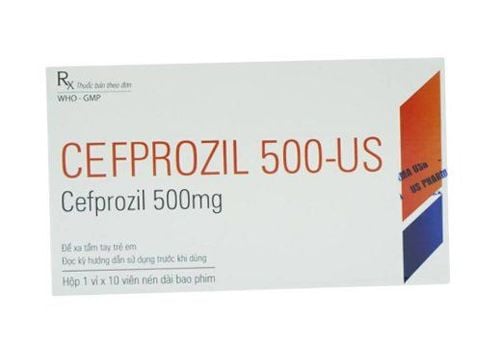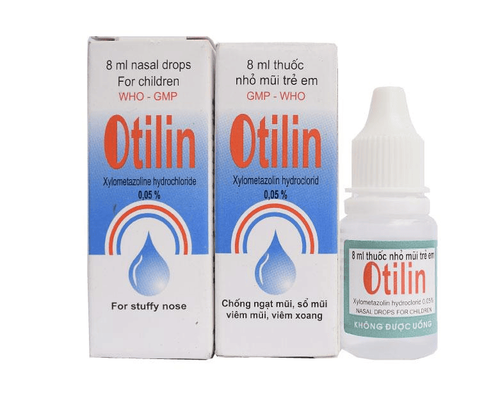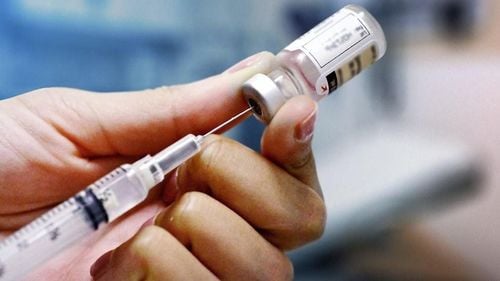This is an automatically translated article.
Anikef sterile 1.5g is a powder for injection with the main ingredient being 1.5g Cefuroxime in the form of Cefuroxime sodium. So what is Anikef sterile medicine and what does it do?1. What is Anikef sterile medicine?
Anikef sterile 1.5g is an antibiotic that is prepared in the form of a powder for injection. The main ingredient of the drug is Cefuroxime, this is a semi-synthetic broad-spectrum antibiotic, belonging to the cephalosporin group, sodium salt injection, oral axetil ester.Cefuroxime axetil is a prodrug of cefuroxime, which has very little antibacterial activity when it is not hydrolyzed to cefuroxime in the body after the drug is absorbed.
Cefuroxime has antibacterial activity due to its ability to inhibit bacterial cell wall synthesis by binding to essential target proteins. Currently, there are also bacteria resistant to cefuroxime, which can be caused by the bacteria secreting the enzyme cephalosporinase, or by altering the penicillin-binding proteins.
Cefuroxime has effective and very specific antibacterial activity against many common pathogens, including beta-lactamase/cephalosporinase-producing bacteria strains. Cefuroxime is particularly resistant to beta-lactamase enzymes secreted by gram-negative bacteria.
Anikef sterile 1.5g is indicated in the case of infections caused by susceptible bacteria in the following conditions:
Respiratory tract infections such as acute and chronic bronchitis, infectious bronchiectasis bacteria, lung abscess, infectious pneumonia and respiratory tract infections after surgery. Ear, nose and throat infections such as sinusitis, tonsillitis and pharyngitis. Urinary tract infections such as acute and chronic pyelonephritis, cystitis and asymptomatic urinary tract infections. Soft tissue infections such as cellulitis, peritonitis, erysipelas and wound infections. Bone and joint infections such as osteomyelitis and infectious arthritis. Infections in obstetrics and gynecology. Pelvic inflammatory disease. Gonorrhea, especially in cases where the antibiotic penicillin has not worked. Other infections include bacteremia and meningitis. Infection prevention in high-risk situations such as abdominal, pelvic, orthopedic, cardiac, pulmonary, esophageal, and vascular surgery. Anikef sterile 1.5g is contraindicated in the following cases:
People who are sensitive to cephalosporin antibiotics. Persons with a history of hypersensitivity to penicillin. Caution when using Anikef sterile 1.5g:
Cefuroxime sodium in Anikef sterile is incompatible with aminoglycosides. Anikef sterile 1.5g solution may darken during storage. Approximately 10% of penicillin-sensitive patients are also allergic to cephalosporins, so caution should be exercised when Anikef sterile 1.5g is administered to patients with a history of penicillin allergy. Anikef sterile 1.5g should be used with caution in patients with renal impairment, it may be necessary to reduce the dose as necessary. Concomitant use of Anikef sterile 1.5g with diuretics such as furosemide and nephrotoxic antibiotics such as gentamicin may increase the risk of renal injury. The patient's renal function and blood count should be closely monitored when using this combination, especially in the case of long-term treatment with high doses. Pregnancy: Tests of Anikef sterile 1.5g in rabbits and rats at doses up to 60 times the human dose did not show any evidence of impaired fertility or harm to the fetus. . However, currently we still do not have enough studies on the use of Anikef sterile 1.5g in pregnant women, so this medicine should only be used in pregnant women when clearly needed. Because cefuroxime is excreted in human milk, caution should be exercised when Anikef sterile 1.5g is administered to a nursing woman.
2. Dosage and how to use Anikef sterile 1.5g
Anikef sterile 1.5g is only used as directed by a doctor. The dosage of Anikef sterile 1.5g should be according to the doctor's prescription, the reference dose for specific cases is as follows:Infections caused by susceptible strains of bacteria: Use the drug by deep intramuscular injection or injection IV slowly over 3 - 5 minutes, or intravenous infusion. Adults: The usual dose is 750 mg of cefuroxime, every 8 hours. In more severe infections, doses up to 1.5g can be used every 6 hours. Children and very young children: Use a dose of 30-60mg/kg body weight/day, the dose can be increased to 100mg/kg/day if necessary, divided into 3-4 small doses. Neonates can be given Anikef sterile 1.5g with the same total daily dose as infants, but divided into 2 or 3 smaller doses. Meningitis caused by susceptible strains of bacteria: Adults: Use the drug by intravenous injection at a dose of 3g, every 8 hours. Children and very young children: Use the drug by intravenous injection at a dose of 200-240mg/kg body weight/day, divided into 3-4 small doses. After 3 days or when there is clinical improvement, the dose can be reduced to 100mg/kg body weight/day. Neonates: Use intravenously at a dose of 100mg/kg/day, the dose can be reduced to 50mg/kg/day when indicated. Penicillin-resistant gonorrhea: Use a single dose of 1.5g. The drug can be divided into 2 injections at 2 different sites, and can be used concurrently with oral probenecid. Prophylaxis of surgical infections: Use the usual dose of 1.5g cefuroxime intravenously before surgery, then continue intravenous or intramuscular with 750mg / time, every 8 hours until the time. 24-48 hours after surgery. In total joint replacement surgery, 1.5g Anikef sterile 1.5g powder can be mixed with methylmethacrylate cement. How to use Anikef sterile 1.5g as follows:
Intramuscular: Add 1ml of water for injection to the 250mg Cefuroxime Sodium vial or 3ml of water for injection into the 750mg Cefuroxime vial. Shake the vial thoroughly until a homogeneous suspension is obtained. Intravenous injection: Dissolve Cefuroxime Sodium with the following amount of water for injection: Use at least 2ml for a 250mg vial, at least 6ml for a 750mg vial and at least 15ml for a 1.5g vial. For rapid intravenous infusion (eg over a period of up to 30 minutes), 1.5g of Cefuroxime may be dissolved in 50ml of water for injection. These solutions can be injected directly into a vein or diluted with fluids. Anikef sterile 1.5g can be diluted with the following intravenous fluids: 0.9% NaCl solution, 5% Dextrose solution, 10% Dextrose solution, 5% Dextrose solution and 0.9% NaCl solution, 5% Dextrose solution and 0.45% NaCl solution, Hartmann's solution. An overdose of Anikef sterile 1.5g can cause brain irritation leading to convulsions. Cefuroxime blood levels can be reduced by hemodialysis.
3. Anikef sterile 1.5g side effects
During the use of Anikef sterile 1.5g, you may experience some side effects of the drug, including:Allergic reactions including rash, urticaria, fever, eosinophilia, Reactions similar to serum sickness and anaphylaxis may occur with treatment with Anikef sterile 1.5g, especially in cases of hypersensitivity to penicillins or other cephalosporin antibiotics. Decrease in neutrophils. Leukopenia. Decreased platelets. Hemolytic anemia. There is a potential for nephrotoxicity with the use of Anikef sterile 1.5g, especially in patients with renal impairment or in patients receiving concomitant nephrotoxic drugs. Transient elevation of liver enzymes. Neurological disorders including encephalopathy also occasionally occur. There may be pain at the injection site after intramuscular injection and thrombophlebitis after intravenous infusion, which usually occurs when Anikef sterile 1.5g is used more than 6g/day for more than 3 consecutive days. Prolonged use of Anikef sterile 1.5g may lead to overgrowth of non-susceptible organisms. Pseudomembranous colitis may occur. If you see any unusual symptoms when using Anikef sterile 1.5g, you need to immediately notify your doctor for timely treatment.
4. Interaction of Anikef sterile 1.5g with other drugs
Concomitant use of Anikef sterile 1.5g with Probenecid will reduce renal tubular secretion of cefuroxime, resulting in increased plasma concentrations, prolonging the half-life of the drug, thereby increasing the risk of toxicity in kidney. Anikef sterile 1.5g and probenecid can be used concurrently in the treatment of bacterial infections such as sexually transmitted diseases (STDs) or infections requiring prolonged and high concentrations of antibiotics. in plasma and in tissues. Mixing Anikef sterile 1.5g and amino-glycosides may inactivate each other. If concurrent use is required, the injection should be administered at separate sites. Do not mix these drugs in the same syringe or in the same infusion bottle. Sodium bicarbonate injection should not be used to dilute Anikef sterile 1.5g.Please dial HOTLINE for more information or register for an appointment HERE. Download MyVinmec app to make appointments faster and to manage your bookings easily.













